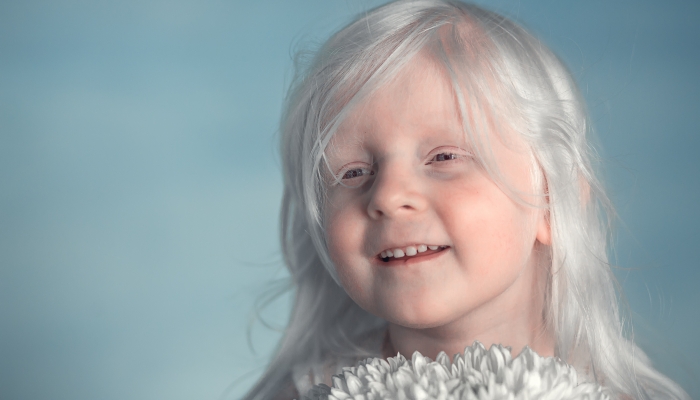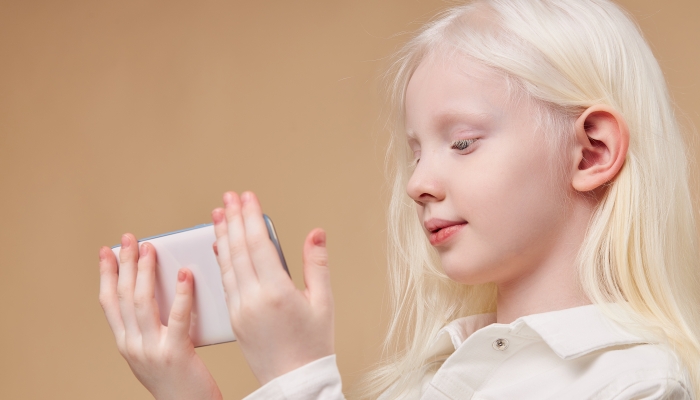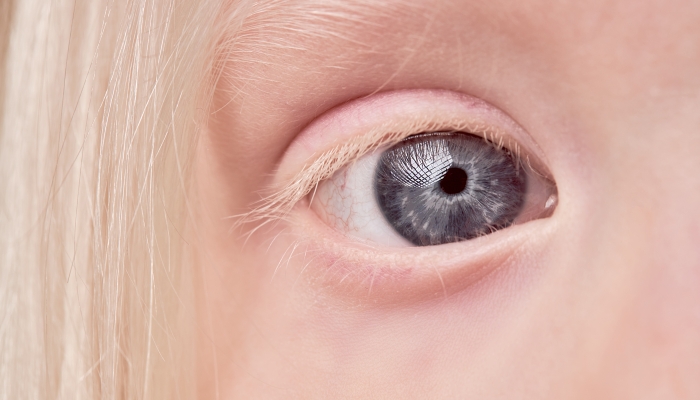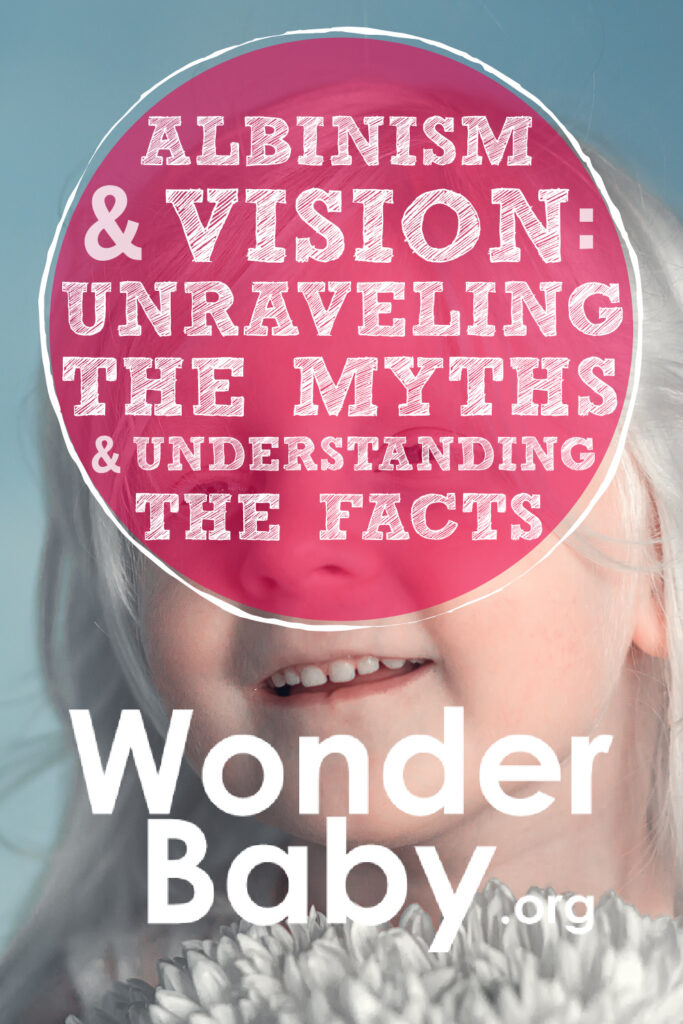Albinism and Vision: Unraveling the Myths and Understanding the Facts

- Albinism is a genetic condition that affects the pigment that colors the skin, hair, and eyes.
- Ocular albinism affects only the melanin in the eyes, whereas oculocutaneous albinism also impacts the melanin in the skin and hair.
- Melanin plays a crucial role in the development of the eyes; without the proper amount of melanin, eye development can be compromised.
- Low vision is a common characteristic of albinism, but low vision aids may help to improve vision.
Albinism is a rare genetic condition that affects the production of melanin, the pigment that gives color to the skin, hair, and eyes. Ocular albinism impacts only the melanin in the eyes, but oculocutaneous albinism reduces the melanin in the eyes, skin, and hair. Albinism is a condition you have for life, but it doesn’t worsen over time.
Some people with albinism have a reduced amount of melanin, and others have no melanin at all.
People often mistakenly assume people with albinism have very pale skin and hair color, but this is not always the case. People with albinism may have white or very light hair, although it’s possible to have brown or ginger hair with albinism. People with albinism may have pale or very light skin that burns easily when exposed to the sun.
Though albinism can impact eyesight, there are lots of myths and misconceptions about albinism and vision. Melanin plays an important role in the retina’s development; the retina is a light-sensitive layer of cells in the eye that translates what you see into electrical signals for your brain. Albinism can cause vision problems because of the reduced amount of melanin in the body.
Myths and Misconceptions About Albinism and Vision

Unfortunately, there are lots of misconceptions about albinism and eyesight. If you have a child with albinism, you may find yourself frustrated by people’s assumptions about your child’s condition.
Myth 1: All people with albinism are blind.
Some mistakenly believe that everyone with albinism is blind. This isn’t accurate, though the condition is associated with vision problems. People with albinism can have varying degrees of vision problems, so it’s wrong to assume everybody with this condition sees the same.
While some people with albinism may be legally blind, this is a legal definition and doesn’t mean completely blind. Legally blind simply means vision that is not correctable to better than 20/200, so even people classified as legally blind may be able to see more than you imagine when you hear the term “blind.”
Some people with albinism may have a lack of visual clarity, meaning they need to be very close to something to see the finer details.
Another vision condition associated with albinism is a constant involuntary movement of the eye called nystagmus. The constant eye movement that makes it difficult to focus on moving objects.
Some people with albinism may have reduced depth perception, impacting daily activities such as driving and sports. People with albinism may be near or far-sighted or suffer from blurred vision. Some may suffer from photophobia, which means their eyes are very sensitive to light, which can cause discomfort.
Myth 2: People with albinism have red eyes.
When you say the word albinism, a lot of people will immediately picture a person with pink or red eyes. People with albinism can have various eye colors, including light gray, blue, and even brown. When light reflects off the back of the eye, you may notice a pink or red color similar to the red eye produced by a camera flash which happens to everyone.
Myth 3: Albinism is a sign of other cognitive or physical disabilities.
Nope! Albinism is a pigment disorder that can impact vision because of melanin’s vital role in the retina’s development. Albinism impacts the coloring of the hair, skin, and eyes and causes reduced vision to varying degrees, but it does not impact any other aspects of a person’s health or cognitive ability.
Having albinism is not a sign of other cognitive or physical disabilities. If a person with albinism has other cognitive or physical disabilities, this is not related to the fact that they have albinism.
Myth 4: People with albinism can’t be exposed to any light.
It’s a common misconception that people with albinism can’t be exposed to any light. In fact, most are able to live a normal life with the help of some sun protection. Due to the reduced melanin in their skin, people with albinism may burn more easily in the sun, which puts them at an increased risk of developing skin cancer.
People with albinism should wear high-SPF sunscreen to protect their skin from the sun. It’s also important to monitor any changes that could be indicative of skin cancer. Such as new moles, growths, or lumps. You should also visit your doctor if you notice any moles, freckles, or patches of skin changing size, shape, or color.
Some people with albinism may suffer from light sensitivity, which can cause discomfort when under bright light. There are, however, tinted glasses and contact lenses that can be used to reduce discomfort. With a few precautions, albinism shouldn’t hold anyone back in life.
Myth 5: Albinism can be cured or lessened with certain treatments.
Albinism is a genetic condition. There is no cure for albinism, and any treatments are used to manage symptoms but cannot cure the condition. The treatment options to help manage symptoms include vision correction, such as glasses or contact lenses, and sunscreen to protect the skin from the sun’s harmful rays.
How Does Albinism Affect Vision?

Vision issues are common in those with albinism. One type of albinism called ocular albinism, or X-linked ocular albinism, affects only the eyes. Melanin is crucial for eye development, so the reduced or complete lack of melanin associated with albinism can impact vision.
Vision Impairments Associated with Albinism
Nystagmus
Nystagmus is a condition characterized by involuntary eye movements. These movements are rhythmic and repetitive, and the person with nystagmus is unable to control the movements. These movements can be up and down, from side to side, or round in a circle. Some people with nystagmus tilt their heads to the side to see better.
Strabismus
Strabismus is a misalignment of the eyes that leads to a head tilt for improved vision. This condition is often seen in people with albinism.
Photophobia
Sensitivity to light is common among people with albinism. The lack of pigmentation in the iris means the eye is unable to filter out stray light, and this can lead to discomfort when faced with bright light.
Reduced Visual Acuity
The eye is a complicated piece of equipment, and without the melanin necessary for proper development, many problems can arise. One of the main problems facing people with albinism is reduced visual acuity (being able to see clearly).
There are various reasons why vision may be impacted by albinism, but low visual acuity is the most likely symptom. When eye development is impacted, future visual acuity will likely be reduced. While some people may get by with glasses or contacts to improve their vision, others may experience more limited vision.
Foveal Hypoplasia
Due to insufficient amounts of melanin associated with albinism, the foveal pit doesn’t develop correctly or at all. This ocular abnormality is known as foveal hypoplasia and is associated with low visual acuity and nystagmus.
Optic Nerve Misrouting
Melanin is needed for optimal development of the optic nerve. The optic nerve has some fibers that remain on one side of the brain and others that cross over. Melanin is responsible for the signal indicating what each fiber should do. A lack of melanin can result in optic nerve misrouting, which causes poor depth perception.
Interventions for Vision Impairments in Albinism

There is no cure for ocular albinism, but there are interventions that can manage the symptoms for some people with albinism.
Optical Solutions
Prescription Glasses and Contact Lenses
Ocular albinism impacts visual acuity, but for many people, this can be corrected with prescription glasses and contact glasses. Tinted lenses can help ease symptoms of photophobia—you can even get tinted contact lenses.
Vision Therapy
Eye Exercises to Manage Nystagmus and Strabismus
If your child is struggling with nystagmus and strabismus, their eye doctor should be able to recommend some eye exercises to help. Regular eye exercises can help to reduce symptoms of these conditions and improve vision.
Surgical Interventions
Surgery can, in some cases, help to improve vision for people with albinism. If, for example, you struggle from strabismus and this is impacting your vision, your eye doctor may recommend strabismus correction surgery.
Living with Albinism: Tips and Coping Strategies

Your child may need to adapt coping strategies to help manage life with albinism. While their eye doctor will address any vision issues, they may also need help managing light sensitivity and dealing with the social aspects of albinism.
Managing Light Sensitivity
With albinism, taking precautions to protect against the sun is extra important. Wearing sunglasses will help if your child suffers from light sensitivity. Sensitivity to sunlight can cause discomfort when spending time outside, and sunglasses can help to reduce any discomfort. You can also opt for tinted lenses, which can help to reduce the discomfort caused by light sensitivity.
Indoors, bright lights can be problematic for people with light sensitivity. To avoid this, you should replace any bright bulbs with dimmer bulbs. You could also opt for lamps rather than bright ceiling lights in your home. Try to create a home environment where your child feels comfortable.
Navigating the Social Landscape
It’s not always easy to stand out. If your child has very light hair or other features associated with albinism, you may notice they receive more than their fair share of stares when out in public.
How can you help your child deal with these intrusions and the inevitable questions they’ll receive from total strangers?
Firstly, you and your child should remember that strangers have no right to your child’s medical history. People may ask intrusive questions, but you don’t need to answer them. In fact, it’s perfectly okay to say something simple like, “That’s a very personal question.” Not only will this protect your child’s right to privacy, but it will also model how to navigate unwanted personal questions.
If you want to educate people about albinism, you can do this without using your child’s personal information. For example, you can give general information about the condition rather than sharing your child’s experiences. If your child wants to share their experiences, that’s fine, but you should try to avoid doing it for them.
There are plenty of myths still circulating about albinism. Now that you’re clued up about albinism, you’ll be equipped to counter these myths when you come up against them in real life. It’s always worth pointing out fact from fiction because misconceptions can be harmful to people with albinism.
Connecting with Support Groups

Your child will benefit hugely from connections to other people who share their condition. Though people with albinism experience different variations of vision problems, and though they may not experience their condition or the world in the same way, connecting with other people with albinism can help.
If your child is the only child with albinism in their school or community, seeking out others can help your child feel less alone. In-person connections are vital to our desire to fit in and feel like part of a community. Search online for a local support group or community, so you and your child can make meaningful connections with other people with albinism.
If your child has vision problems or blindness associated with albinism, it may help to reach out to support groups for children with visual impairment.
Making connections with other parents will be beneficial for you, too. Not only will these families understand your child’s condition and your experiences, but they’ll also likely share your concerns and experiences.
It’s also important to ensure you’re getting the right support for you and your child. Hopefully, your healthcare provider has signposted you to local services offering support, but if not, you should look for local charities and organizations offering information and resources to families living with albinism.

The information WonderBaby provides is not intended to be, and does not constitute, medical or other health advice or diagnosis and should not be used as such. Always consult with a qualified medical professional about your specific circumstances.
Related Posts

Eye Conditions and Syndromes, Visual Impairment
Neuralink Announces Plans to Restore Sight to the Blind with Brain Chip
Elon Musk’s company Neuralink has announced plans to begin human trials of its new “Blindsight” brain chip by the end of 2025.

Visual Impairment
The Gift of Understanding: How a Young Child Helps His Blind Father Navigate Life
When a parent is blind, it’s natural for people to wonder how their sighted child will adapt. Will they struggle to understand their parent’s needs? Will they feel burdened by...

Braille and Literacy, Toys, Visual Impairment
24 Braille Toys for Kids Who are Blind
Everything from alphabet blocks to raised line coloring pages and activity books to puzzles to card and board games... and so much more! And it's all in braille ready for...